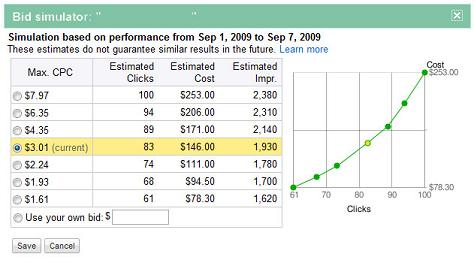The Adwords Bid Simulator - What's Really Going on Here?
 Google likes to come up with new and helpful tools to make it easier to manage an Adwords account to reach their goals. Wait what? Yup, most of the suave little tools they come up with are tilted in their favor not yours! Like I've said before Google is just like Vegas, the house always wins. The more information they give you, the more paranoid you feel about how much you are bidding. The First Page Bid info that was launched a while back basically gives you what they want you to bid to get on the first page of search results. Can you get on the first page for less? Oftentimes yes. Will most people just blindly believe the First Page Bid and apply it directly to their account without testing it? Oftentimes yes. Apparently this was such a hit with the accounting department they decided to up the ante and introduce the Bid Simulator. Now they're leveraging impressions against your bid in an effort to extract more money from your wallet. Tread lightly with this one kids!
Google likes to come up with new and helpful tools to make it easier to manage an Adwords account to reach their goals. Wait what? Yup, most of the suave little tools they come up with are tilted in their favor not yours! Like I've said before Google is just like Vegas, the house always wins. The more information they give you, the more paranoid you feel about how much you are bidding. The First Page Bid info that was launched a while back basically gives you what they want you to bid to get on the first page of search results. Can you get on the first page for less? Oftentimes yes. Will most people just blindly believe the First Page Bid and apply it directly to their account without testing it? Oftentimes yes. Apparently this was such a hit with the accounting department they decided to up the ante and introduce the Bid Simulator. Now they're leveraging impressions against your bid in an effort to extract more money from your wallet. Tread lightly with this one kids!So here's an example of the Bid Simulator for you to check out. This is out of a fairly competitive national campaign. The estimator is not bad when you compare it to real life, we did get 87 clicks at the current bid with a solid position 1.1 and a 4.52% CTR. However the tool is recommending increasing the bid to $7.97 from $3.01 which is a whopping 165% increase. For the extra money we get an additional 450 impressions and 17 clicks with a 3.7% CTR (notice they don't do that math for you) which is much lower than the current performance. Since CTR is a large part of quality score, the likely effect of this will be to drive your quality score down resulting in a need for a higher bid to hold your current position. By the way, look at how easy it is to just pick a button to make the change... compare that with the click maze required to turn off the Content Network. < sarcasm >Weird that one would be so much easier than the other. < /sarcasm >

So here's my big question: where are all these extra impressions coming from? I mean I'm not losing them to position, improving on position 1 is somewhat problematic, so what's up? Break out your tinfoil helmets; I have 2 (conspiracy) theories about it.
1. Google is holding impressions hostage
So my first theory is that even though your current bid is totally adequate, Google thinks it's not enough. They let you rank highly when you serve, but they hold back on how many impressions you get. If you're going to get the rest of the impressions you're going to have to bid what they want you to bid. The price of the impression ransom is right there in the Bid Simulator waiting for you to save the day.
2. The extra impressions are born of extended broad match mixed with irresponsible bidding
My other theory is that there will always be more impressions if more money is involved. The keyword matching will get looser and looser to accommodate your obvious disregard for money. I would venture to say that a big percentage of those "missed" impressions are garbage that you didn't want in the first place.
Although the Bid Simulator is interesting, I think it's more of an attempt to make you bid higher than it is to help your account. Think about it, Google offers you new impressions of questionable value from a mystery source. You feel compelled to get in on the action and pick one of the pretty radio buttoned options presented to you. 2 or 3 of your competitors do the same thing and now the competition for your niche ad space has just jumped up by multiple dollars. Who wins in this transaction? Not you, Google. I highly recommend that you do your own testing to find real impression levels and watch your search query reports closely to ensure you're not getting loads of off topic clicks. An attentive mind will beat fancy tools and automation every time.
Labels: adwords, bid_simulator, bidding strategy









